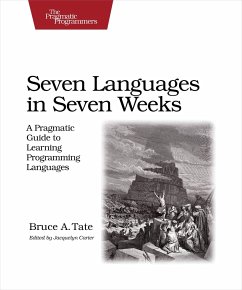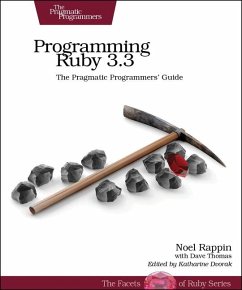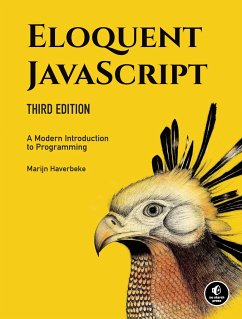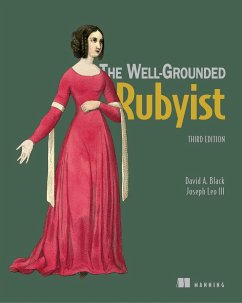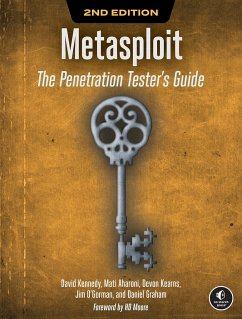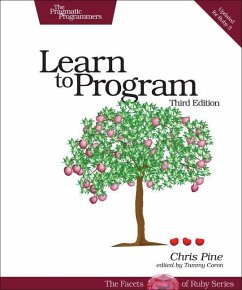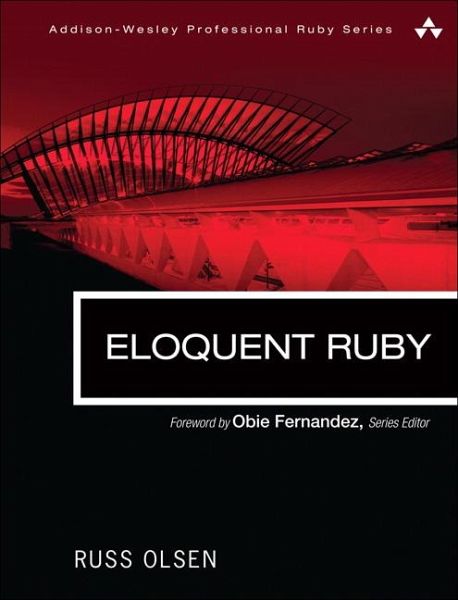
Eloquent Ruby
Versandkostenfrei!
Versandfertig in 1-2 Wochen
32,99 €
inkl. MwSt.
Weitere Ausgaben:

PAYBACK Punkte
16 °P sammeln!
It's easy to write "correct" Ruby code. But it's far harder to gain the fluency needed to write great Ruby code. To do that, you need to go beyond syntax and absorb the "Ruby way" of thinking and problem solving. In Eloquent Ruby, Russ Olsen helps you understand Ruby like true Rubyists do-so you can leverage its immense, surprising power.
Olsen draws on years of experience internalizing the Ruby culture and teaching Ruby to other programmers. He guides you to the "Ah Ha!" moments when it suddenly becomes clear why Ruby works the way it does and how you can take advantage of its unique approach.
Eloquent Ruby starts small, answering tactical questions focused on a single statement, method, test, or bug. You'll learn how to write code that actually looks like Ruby (not Java); why Ruby has so many control structures; how to use strings, expressions, and symbols; and what dynamic typing is really good for.
Next, Olsen turns to bigger questions related to building methods and classes. You'll discover why Ruby classes contain so many tiny methods, when to use operator overloading, and when to avoid it. Olsen explains how to write Ruby code that writes its own code-and why you'll want to. He concludes with powerful project-level features and techniques ranging from gems to Domain Specific Languages.
The newest book in the renowned Addison-Wesley Professional Ruby Series, Eloquent Ruby will help you "put on your Ruby-colored glasses" and get results that make you a true believer.
Product Description
It's easy to write correct Ruby code, but to gain the fluency needed to write great Ruby code, you must go beyond syntax and absorb the "Ruby way" of thinking and problem solving. In Eloquent Ruby, Russ Olsen helps you write Ruby like true Rubyists do-so you can leverage its immense, surprising power.
Olsen draws on years of experience internalizing the Ruby culture and teaching Ruby to other programmers. He guides you to the "Ah Ha!" moments when it suddenly becomes clear why Ruby works the way it does, and how you can take advantage of this language's elegance and expressiveness.
Eloquent Ruby starts small, answering tactical questions focused on a single statement, method, test, or bug. You'll learn how to write code that actually looks like Ruby (not Java or C#); why Ruby has so many control structures; how to use strings, expressions, and symbols; and what dynamic typing is really good for.
Next, the book addresses bigger questions related to building methods and classes. You'll discover why Ruby classes contain so many tiny methods, when to use operator overloading, and when to avoid it. Olsen explains how to write Ruby code that writes its own code-and why you'll want to. He concludes with powerful project-level features and techniques ranging from gems to Domain Specific Languages.
A part of the renowned Addison-Wesley Professional Ruby Series, Eloquent Ruby will help you "put on your Ruby-colored glasses" and get results that make you a true believer.
Foreword xix
Preface xxi
Acknowledgments xxv
About the Author xxvii
PART I: The Basics 1
Chapter 1: Write Code That Looks Like Ruby 3
The Very Basic Basics 4
Go Easy on the Comments 6
Camels for Classes, Snakes Everywhere Else 8
Parentheses Are Optional but Are Occasionally Forbidden 9
Folding Up Those Lines 10
Folding Up Those Code Blocks 11
Staying Out of Trouble 12
In the Wild 13
Wrapping Up 15
Chapter 2: Choose the Right Control Structure 17
If, Unless, While, and Until 17
Use the Modifier Forms Where Appropriate 19
Use each, Not for 20
A Case of Programming Logic 21
Staying Out of Trouble 23
In the Wild 25
Wrapping Up 27
Chapter 3: Take Advantage of Ruby's Smart Collections 29
Literal Shortcuts 29
Instant Arrays and Hashes from Method Calls 30
Running Through Your Collection 33
Beware the Bang! 36
Rely on the Order of Your Hashes 38
In the Wild 38
Staying Out of Trouble 40
Wrapping Up 42
Chapter 4: Take Advantage of Ruby's Smart Strings 43
Coming Up with a String 44
Another API to Master 47
The String: A Place for Your Lines, Characters, and Bytes 49
In the Wild 50
Staying Out of Trouble 51
Wrapping Up 52
Chapter 5: Find the Right String with Regular Expressions 53
Matching One Character at a Time 54
Sets, Ranges, and Alternatives 55
The Regular Expression Star 57
Regular Expressions in Ruby 58
Beginnings and Endings 60
In the Wild 62
Staying Out of Trouble 63
Wrapping Up 64
Chapter 6: Use Symbols to Stand for Something 65
The Two Faces of Strings 65
Not Quite a String 66
Optimized to Stand for Something 67
In the Wild 69
Staying Out of Trouble 70
Wrapping Up 71
Chapter 7: Treat Everything Like an Object-Because Everything Is 73
A Quick Review of Classes, Instances, and Methods 74
Objects All the Way Down 76
The Importance of Being an Object 77
Public, Private, and Protected 79
In the Wild 81
Staying Out of Trouble 82
Wrapping Up 84
Chapter 8: Embrace Dynamic Typing 85
Shorter Programs, But Not the Way You Think 85
Extreme Decoupling 89
Required Ceremony Versus Programmer-Driven Clarity 92
Staying Out of Trouble 93
In the Wild 94
Wrapping Up 96
Chapter 9: Write Specs! 97
Test::Unit: When Your Documents Just Have to Work 98
A Plethora of Assertions 101
Don't Test It, Spec It! 101
A Tidy Spec Is a Readable Spec 104
Easy Stubs 105
. . . And Easy Mocks 107
In the Wild 108
Staying Out of Trouble 110
Wrapping Up 113
PART II: Classes, Modules, and Blocks 115
Chapter 10: Construct Your Classes from Short, Focused Methods 117
Compressing Specifications 117
Composing Methods for Humans 121
Composing Ruby Methods 122
One Way Out? 123
Staying Out of Trouble 126
In the Wild 127
Wrapping Up 128
Chapter 11: Define Operators Respectfully 129
Defining Operators in Ruby 129
A Sampling of Operators 131
Operating Across Classes 134
Staying Out of Trouble 135
In the Wild 137
Wrapping Up 139
Chapter 12: Create Classes That Understand Equality 141
An Identifier for Your Documents 141
An Embarrassment of Equality 142
Double Equals for Everyday Use 143
Broadening the Appeal of the == Method 145
Well-Behaved Equality 146
Triple Equals for Case Statements 149
Hash Tables and the eql? Method 150
Building a Well-Behaved Hash Key 152
Staying Out of Trouble 153
In the Wild 154
Wrapping Up 156
Chapter 13: Get the Behavior You Need with Singleton and Class Methods 157
A Stubby Puzzle 158
A Hidden, but Real Class 160
Class Methods: Singletons in Plain Sight 162
In the Wild 164
Staying Out of Trouble 165
Wrapping Up 167
Chapter 14: Use Class Instance Variables 169
A Quick Review of Class Variables 169
Wandering Variables 171
Getting Control of the Data in Your Class 174
Class Instance Variables and Subclasses 175
Adding Some Convenience to Your Class Instance Variables 176
In the Wild 177
Staying Out of Trouble 179
Wrapping Up 179
Chapter 15: Use Modules as Name Spaces 181
A Place for Your Stuff, with a Name 181
A Home for Those Utility Methods 184
Building Modules a Little at a Time 185
Treat Modules Like the Objects That They Are 186
Staying Out of Trouble 189
In the Wild 190
Wrapping Up 191
Chapter 16: Use Modules as Mixins 193
Better Books with Modules 193
Mixin Modules to the Rescue 195
Extending a Module 197
Staying Out of Trouble 198
In the Wild 202
Wrapping Up 205
Chapter 17: Use Blocks to Iterate 207
A Quick Review of Code Blocks 207
One Word after Another 209
As Many Iterators as You Like 210
Iterating over the Ethereal 211
Enumerable: Your Iterator on Steroids 213
Staying Out of Trouble 215
In the Wild 217
Wrapping Up 218
Chapter 18: Execute Around with a Block 219
Add a Little Logging 219
When It Absolutely Must Happen 224
Setting Up Objects with an Initialization Block 225
Dragging Your Scope along with the Block 225
Carrying the Answers Back 227
Staying Out of Trouble 228
In the Wild 229
Wrapping Up 231
Chapter 19: Save Blocks to Execute Later 233
Explicit Blocks 233
The Call Back Problem 234
Banking Blocks 236
Saving Code Blocks for Lazy Initialization 237
Instant Block Objects 239
Staying Out of Trouble 240
In the Wild 243
Wrapping Up 244
PART III: Metaprogramming 247
Chapter 20: Use Hooks to Keep Your Program Informed 249
Waking Up to a New Subclass 250
Modules Want To Be Heard Too 253
Knowing When Your Time Is Up 255
. . . And a Cast of Thousands 256
Staying Out of Trouble 257
In the Wild 259
Wrapping Up 261
Chapter 21: Use method_missing for Flexible Error Handling 263
Meeting Those Missing Methods 264
Handling Document Errors 266
Coping with Constants 267
In the Wild 268
Staying Out of Trouble 270
Wrapping Up 271
Chapter 22: Use method_missing for Delegation 273
The Promise and Pain of Delegation 274
The Trouble with Old-Fashioned Delegation 275
The method_missing Method to the Rescue 277
More Discriminating Delegation 278
Staying Out of Trouble 279
In the Wild 281
Wrapping Up 283
Chapter 23: Use method_missing to Build Flexible APIs 285
Building Form Letters One Word at a Time 286
Magic Methods from method_missing 287
It's the Users That Count-All of Them 289
Staying Out of Trouble 289
In the Wild 290
Wrapping Up 292
Chapter 24: Update Existing Classes with Monkey Patching 293
Wide-Open Classes
Olsen draws on years of experience internalizing the Ruby culture and teaching Ruby to other programmers. He guides you to the "Ah Ha!" moments when it suddenly becomes clear why Ruby works the way it does and how you can take advantage of its unique approach.
Eloquent Ruby starts small, answering tactical questions focused on a single statement, method, test, or bug. You'll learn how to write code that actually looks like Ruby (not Java); why Ruby has so many control structures; how to use strings, expressions, and symbols; and what dynamic typing is really good for.
Next, Olsen turns to bigger questions related to building methods and classes. You'll discover why Ruby classes contain so many tiny methods, when to use operator overloading, and when to avoid it. Olsen explains how to write Ruby code that writes its own code-and why you'll want to. He concludes with powerful project-level features and techniques ranging from gems to Domain Specific Languages.
The newest book in the renowned Addison-Wesley Professional Ruby Series, Eloquent Ruby will help you "put on your Ruby-colored glasses" and get results that make you a true believer.
Product Description
It's easy to write correct Ruby code, but to gain the fluency needed to write great Ruby code, you must go beyond syntax and absorb the "Ruby way" of thinking and problem solving. In Eloquent Ruby, Russ Olsen helps you write Ruby like true Rubyists do-so you can leverage its immense, surprising power.
Olsen draws on years of experience internalizing the Ruby culture and teaching Ruby to other programmers. He guides you to the "Ah Ha!" moments when it suddenly becomes clear why Ruby works the way it does, and how you can take advantage of this language's elegance and expressiveness.
Eloquent Ruby starts small, answering tactical questions focused on a single statement, method, test, or bug. You'll learn how to write code that actually looks like Ruby (not Java or C#); why Ruby has so many control structures; how to use strings, expressions, and symbols; and what dynamic typing is really good for.
Next, the book addresses bigger questions related to building methods and classes. You'll discover why Ruby classes contain so many tiny methods, when to use operator overloading, and when to avoid it. Olsen explains how to write Ruby code that writes its own code-and why you'll want to. He concludes with powerful project-level features and techniques ranging from gems to Domain Specific Languages.
A part of the renowned Addison-Wesley Professional Ruby Series, Eloquent Ruby will help you "put on your Ruby-colored glasses" and get results that make you a true believer.
Foreword xix
Preface xxi
Acknowledgments xxv
About the Author xxvii
PART I: The Basics 1
Chapter 1: Write Code That Looks Like Ruby 3
The Very Basic Basics 4
Go Easy on the Comments 6
Camels for Classes, Snakes Everywhere Else 8
Parentheses Are Optional but Are Occasionally Forbidden 9
Folding Up Those Lines 10
Folding Up Those Code Blocks 11
Staying Out of Trouble 12
In the Wild 13
Wrapping Up 15
Chapter 2: Choose the Right Control Structure 17
If, Unless, While, and Until 17
Use the Modifier Forms Where Appropriate 19
Use each, Not for 20
A Case of Programming Logic 21
Staying Out of Trouble 23
In the Wild 25
Wrapping Up 27
Chapter 3: Take Advantage of Ruby's Smart Collections 29
Literal Shortcuts 29
Instant Arrays and Hashes from Method Calls 30
Running Through Your Collection 33
Beware the Bang! 36
Rely on the Order of Your Hashes 38
In the Wild 38
Staying Out of Trouble 40
Wrapping Up 42
Chapter 4: Take Advantage of Ruby's Smart Strings 43
Coming Up with a String 44
Another API to Master 47
The String: A Place for Your Lines, Characters, and Bytes 49
In the Wild 50
Staying Out of Trouble 51
Wrapping Up 52
Chapter 5: Find the Right String with Regular Expressions 53
Matching One Character at a Time 54
Sets, Ranges, and Alternatives 55
The Regular Expression Star 57
Regular Expressions in Ruby 58
Beginnings and Endings 60
In the Wild 62
Staying Out of Trouble 63
Wrapping Up 64
Chapter 6: Use Symbols to Stand for Something 65
The Two Faces of Strings 65
Not Quite a String 66
Optimized to Stand for Something 67
In the Wild 69
Staying Out of Trouble 70
Wrapping Up 71
Chapter 7: Treat Everything Like an Object-Because Everything Is 73
A Quick Review of Classes, Instances, and Methods 74
Objects All the Way Down 76
The Importance of Being an Object 77
Public, Private, and Protected 79
In the Wild 81
Staying Out of Trouble 82
Wrapping Up 84
Chapter 8: Embrace Dynamic Typing 85
Shorter Programs, But Not the Way You Think 85
Extreme Decoupling 89
Required Ceremony Versus Programmer-Driven Clarity 92
Staying Out of Trouble 93
In the Wild 94
Wrapping Up 96
Chapter 9: Write Specs! 97
Test::Unit: When Your Documents Just Have to Work 98
A Plethora of Assertions 101
Don't Test It, Spec It! 101
A Tidy Spec Is a Readable Spec 104
Easy Stubs 105
. . . And Easy Mocks 107
In the Wild 108
Staying Out of Trouble 110
Wrapping Up 113
PART II: Classes, Modules, and Blocks 115
Chapter 10: Construct Your Classes from Short, Focused Methods 117
Compressing Specifications 117
Composing Methods for Humans 121
Composing Ruby Methods 122
One Way Out? 123
Staying Out of Trouble 126
In the Wild 127
Wrapping Up 128
Chapter 11: Define Operators Respectfully 129
Defining Operators in Ruby 129
A Sampling of Operators 131
Operating Across Classes 134
Staying Out of Trouble 135
In the Wild 137
Wrapping Up 139
Chapter 12: Create Classes That Understand Equality 141
An Identifier for Your Documents 141
An Embarrassment of Equality 142
Double Equals for Everyday Use 143
Broadening the Appeal of the == Method 145
Well-Behaved Equality 146
Triple Equals for Case Statements 149
Hash Tables and the eql? Method 150
Building a Well-Behaved Hash Key 152
Staying Out of Trouble 153
In the Wild 154
Wrapping Up 156
Chapter 13: Get the Behavior You Need with Singleton and Class Methods 157
A Stubby Puzzle 158
A Hidden, but Real Class 160
Class Methods: Singletons in Plain Sight 162
In the Wild 164
Staying Out of Trouble 165
Wrapping Up 167
Chapter 14: Use Class Instance Variables 169
A Quick Review of Class Variables 169
Wandering Variables 171
Getting Control of the Data in Your Class 174
Class Instance Variables and Subclasses 175
Adding Some Convenience to Your Class Instance Variables 176
In the Wild 177
Staying Out of Trouble 179
Wrapping Up 179
Chapter 15: Use Modules as Name Spaces 181
A Place for Your Stuff, with a Name 181
A Home for Those Utility Methods 184
Building Modules a Little at a Time 185
Treat Modules Like the Objects That They Are 186
Staying Out of Trouble 189
In the Wild 190
Wrapping Up 191
Chapter 16: Use Modules as Mixins 193
Better Books with Modules 193
Mixin Modules to the Rescue 195
Extending a Module 197
Staying Out of Trouble 198
In the Wild 202
Wrapping Up 205
Chapter 17: Use Blocks to Iterate 207
A Quick Review of Code Blocks 207
One Word after Another 209
As Many Iterators as You Like 210
Iterating over the Ethereal 211
Enumerable: Your Iterator on Steroids 213
Staying Out of Trouble 215
In the Wild 217
Wrapping Up 218
Chapter 18: Execute Around with a Block 219
Add a Little Logging 219
When It Absolutely Must Happen 224
Setting Up Objects with an Initialization Block 225
Dragging Your Scope along with the Block 225
Carrying the Answers Back 227
Staying Out of Trouble 228
In the Wild 229
Wrapping Up 231
Chapter 19: Save Blocks to Execute Later 233
Explicit Blocks 233
The Call Back Problem 234
Banking Blocks 236
Saving Code Blocks for Lazy Initialization 237
Instant Block Objects 239
Staying Out of Trouble 240
In the Wild 243
Wrapping Up 244
PART III: Metaprogramming 247
Chapter 20: Use Hooks to Keep Your Program Informed 249
Waking Up to a New Subclass 250
Modules Want To Be Heard Too 253
Knowing When Your Time Is Up 255
. . . And a Cast of Thousands 256
Staying Out of Trouble 257
In the Wild 259
Wrapping Up 261
Chapter 21: Use method_missing for Flexible Error Handling 263
Meeting Those Missing Methods 264
Handling Document Errors 266
Coping with Constants 267
In the Wild 268
Staying Out of Trouble 270
Wrapping Up 271
Chapter 22: Use method_missing for Delegation 273
The Promise and Pain of Delegation 274
The Trouble with Old-Fashioned Delegation 275
The method_missing Method to the Rescue 277
More Discriminating Delegation 278
Staying Out of Trouble 279
In the Wild 281
Wrapping Up 283
Chapter 23: Use method_missing to Build Flexible APIs 285
Building Form Letters One Word at a Time 286
Magic Methods from method_missing 287
It's the Users That Count-All of Them 289
Staying Out of Trouble 289
In the Wild 290
Wrapping Up 292
Chapter 24: Update Existing Classes with Monkey Patching 293
Wide-Open Classes
Presents information on writing Ruby code, covering such topics as control structures, strings, expressions, building methods, classes, and domain specific languages.




